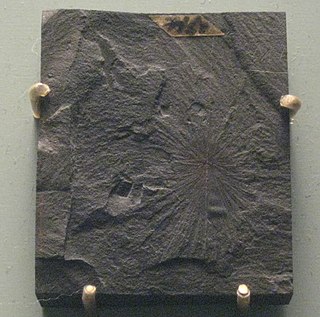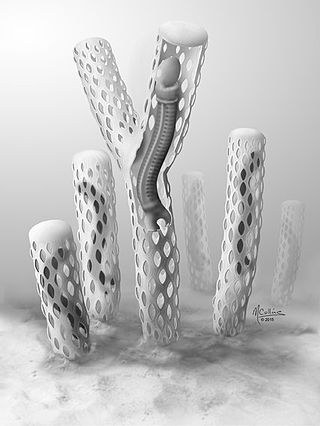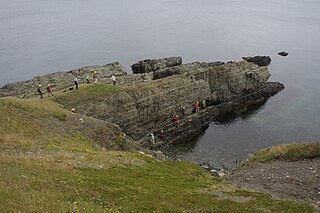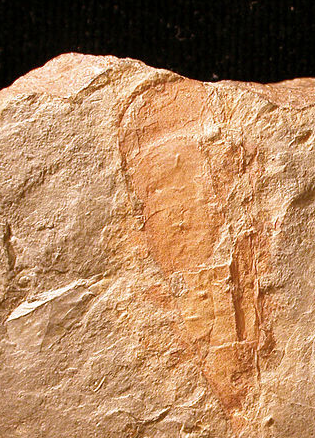
The Burgess Shale is a fossil-bearing deposit exposed in the Canadian Rockies of British Columbia, Canada. It is famous for the exceptional preservation of the soft parts of its fossils. At 508 million years old, it is one of the earliest fossil beds containing soft-part imprints.

The Cambrian Period is the first geological period of the Paleozoic Era, and of the Phanerozoic Eon. The Cambrian lasted 53.4 million years from the end of the preceding Ediacaran Period 538.8 million years ago (mya) to the beginning of the Ordovician Period 485.4 mya. Its subdivisions, and its base, are somewhat in flux.
The Precambrian is the earliest part of Earth's history, set before the current Phanerozoic Eon. The Precambrian is so named because it preceded the Cambrian, the first period of the Phanerozoic Eon, which is named after Cambria, the Latinised name for Wales, where rocks from this age were first studied. The Precambrian accounts for 88% of the Earth's geologic time.

Lobopodians are members of the informal group Lobopodia, or the formally erected phylum Lobopoda Cavalier-Smith (1998). They are panarthropods with stubby legs called lobopods, a term which may also be used as a common name of this group as well. While the definition of lobopodians may differ between literatures, it usually refers to a group of soft-bodied, marine worm-like fossil panarthropods such as Aysheaia and Hallucigenia.

Hallucigenia is a genus of lobopodian, known from Cambrian aged fossils in Burgess Shale-type deposits in Canada and China, and from isolated spines around the world. The generic name reflects the type species' unusual appearance and eccentric history of study; when it was erected as a genus, H. sparsa was reconstructed as an enigmatic animal upside down and back to front. Lobopodians are a grade of Paleozoic panarthropods from which the velvet worms, water bears, and arthropods arose.

Anomalocaris is an extinct genus of radiodont, an order of early-diverging stem-group arthropods.

Choia is a genus of extinct demosponge ranging from the Cambrian until the Lower Ordovician periods. Fossils of Choia have been found in the Burgess Shale in British Columbia; the Maotianshan shales of China; the Wheeler Shale in Utah; and the Lower Ordovician Fezouata formation. It was first described in 1920 by Charles Doolittle Walcott.
The small shelly fauna, small shelly fossils (SSF), or early skeletal fossils (ESF) are mineralized fossils, many only a few millimetres long, with a nearly continuous record from the latest stages of the Ediacaran to the end of the Early Cambrian Period. They are very diverse, and there is no formal definition of "small shelly fauna" or "small shelly fossils". Almost all are from earlier rocks than more familiar fossils such as trilobites. Since most SSFs were preserved by being covered quickly with phosphate and this method of preservation is mainly limited to the late Ediacaran and early Cambrian periods, the animals that made them may actually have arisen earlier and persisted after this time span.

Margaretia is a frondose organism known from the middle Cambrian Burgess shale and the Kinzers Formation of Pennsylvania. Its fronds reached about 10 cm in length and are peppered with a range of length-parallel oval holes. It was originally interpreted as an alcyonarian coral. It was later reclassified as a green alga closely resembling modern Caulerpa by D.F. Satterthwait in her Ph.D. thesis in 1976, a finding supported by Conway Morris and Robison in 1988. More recently, it has been treated as an organic tube, that is used as nest of hemichordate Oesia.
The Cambrian explosion, Cambrian radiation,Cambrian diversification, or the Biological Big Bang refers to an interval of time approximately 538.8 million years ago in the Cambrian Period of early Paleozoic when there was a sudden radiation of complex life and practically all major animal phyla started appearing in the fossil record. It lasted for about 13 – 25 million years and resulted in the divergence of most modern metazoan phyla. The event was accompanied by major diversification in other groups of organisms as well.
Cambrorhytium is an enigmatic fossil genus known from the Latham Shale (California), and the Chengjiang (China) and Burgess Shale lagerstätte. 350 specimens of Cambrorhytium are known from the Greater Phyllopod bed, where they comprise 0.7% of the community.
The cephalopods have a long geological history, with the first nautiloids found in late Cambrian strata, and purported stem-group representatives present in the earliest Cambrian lagerstätten.
Mobergella is a millimetric Lower Cambrian shelly fossil of unknown affinity, usually preserved in phosphate and particularly well known from Swedish strata, where it is diagnostic of lowermost Cambrian rocks. Originally interpreted as a monoplacophoran, the circular, cap-shaped shell resembles a hyolith operculum, with concentric rings on its upper surface, and seven pairs of internal muscle scars. It is never found in association with a conch, and its affinity therefore remains undetermined. Nevertheless, its heavy musculature does seem to indicate that it functioned as an operculum.

The Terreneuvian is the lowermost and oldest series of the Cambrian geological system. Its base is defined by the first appearance datum of the trace fossil Treptichnus pedum around 538.8 million years ago. Its top is defined as the first appearance of trilobites in the stratigraphic record around 521 million years ago. This series' name was formally accepted by the International Commission on Stratigraphy in 2007.
The Miaolingian is the third Series of the Cambrian Period, and was formally named in 2018. It lasted from about 509 to 497 million years ago and is divided in ascending order into 3 stages: the Wuliuan, Drumian, and Guzhangian. The Miaolingian is preceded by the unnamed Cambrian Series 2 and succeeded by the Furongian series.

Bryngwyn Halt railway station is a disused station that was on the Llanfyllin Branch of the Cambrian Railways. It served the villages of Bwlch-y-cibau and Brynderwen between 1863 and 1965.

The Spence Shale is the middle member of the Langston Formation in southeastern Idaho and northeastern Utah. It is exposed in the Bear River Range, the Wasatch Range and the Wellsville Mountains. It is known for its abundant Cambrian trilobites and the preservation of Burgess Shale-type fossils.
The Buen Formation is a geologic formation and Lagerstätte in Peary Land, North Greenland. The shale preserves fossils dating back to the Early Cambrian period.

Houcaris is a possibly paraphyletic radiodont genus, tentatively assigned to either Amplectobeluidae, Anomalocarididae or Tamisiocarididae, known from Cambrian Series 2 of China and the United States. It contains two species, Houcaris saron and Houcaris magnabasis, both of which were originally named as species of the related genus Anomalocaris. The genus Houcaris was established for the two species in 2021 and honors Hou Xianguang, who had discovered and named the type species Anomalocaris saron in 1995 along with his colleagues Jan Bergström and Per E. Ahlberg.










